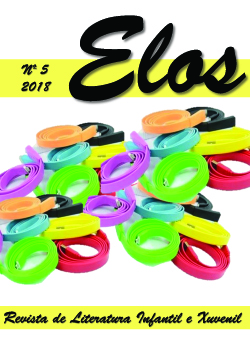New cultural practices in Portugal: Trinta por Uma Linha and Tropelias & Companhia
Main Article Content
Abstract
After making a series of allusions to the Portuguese editorial context linked to Children’s and Youth Literature after the end of Salazar’s dictatorship, they approach the cultural agent term, in which they inscribe the project Trinta por Uma Linha and its impeller, João Manuel Ribeiro, researcher, scholar and teacher of higher education, apart from being a renowned poet and storyteller. It is noted that the catalogs of the two labels that hosts, Trinta Por Uma Linha and Tropelias & Company, reveal a serious and documented bet in the field of Children’s and Youth Literature, by publishing volumes of the authorship of some of the most representative Portuguese names of this literary system and even of others in the process of emergency. These titles include relevant series, a case of “Rimas traquinas”, and propose an important, the only one of the genre in Portugal, collection of studies around the literature for the youngest, the collection “Percursos em Literatura Infantojuvenil”. It is also pointed out the resistance of these imprints for not falling in the difficult economic conditions derived from the crisis that and continue to fulfill an important informational and formative function.
Keywords:
Article Details
References
BROUCKAERT, M. (2008). Oito por un cordel. Xullo 2008. Consultado o 2 de xuño de 2017, http://editoratrintaporumalinha.blogspot.pt/2008/07/oito-por-um-cordel.html
EVEN-ZOHAR, I. (1990). “Polysystem Theory”. Poetics Today, 11 (1), 9-94. Consultado o 2 de xuño de 2017, https://www.jstor.org/stable/1772051?seq=1#page_scan_tab_contents
EVEN-ZOHAR, I. (1994). “La función de la literatura en la creación de las naciones de Europa”. En Villanueva, D. (Ed.). Avances en Teoría de la Literatura: Estética de la Recepción, Pragmática, Teoría Empírica y Teoría de los Polisistemas (pp. 357-377). Santiago de Compostela: Universidade de Santiago de Compostela. Consultado o 2 de xuño de 2017, http://www.tau.ac.il/~itamarez%20/works/papers/trabajos/EZ-function-literatura.pdf
EVEN-ZOHAR, I. (1999). “Factores y dependencias en la cultura. Una revisión de la teoría de los polisistemas”. En Iglesias, M. (Ed. e trad.). Teoría de los polisistemas (pp. 23-52). Madrid: Arco/Libros. Consultado o 2 de xuño de 2017, http://www.tau.ac.il/~itamarez/works/papers/trabajos/EZ-factores-dependencias.pdf
FARIA, Mª. I. e PERICÃO, Mª. da G. (2008). Dicionário do Livro. Coimbra: Almedina.
MARTINELL SEMPERE, A. (2014). Los agentes de la cultura. Consultado o 5 de xuño de 2017, http://atalayagestioncultural.es/capitulo/agentes-cultura
REIS DA SILVA, S. (2016). “Poesia para a Infância: ‘o indispensável supérfluo’ – um percurso pelas ‘Rimas Traquinas”. Revista Expressão, 1, 165-173.
ROIG RECHOU, B-A (2008). La Literatura Infantil y Juvenil Gallega en el siglo XXI. Seis llaves para entenderla mejor/A Literatura Infantil e Xuvenil Galega no século XXI. Seis chaves para entendela mellor. Madrid/Santiago de Compostela: Asociación Española de Amigos del Libro Infantil y Juvenil/Xunta de Galicia. Consultado o 5 de xuño de 2017, http://webspersoais.usc.es/export9/sites/persoais/persoais/blanca.roig/descargas/seis_chaves.pdf
SHAVIT, Z. (1986). Poetics of Children’s Literature. Atenas/Londres: The University of Georgia Press.
SOTTO MAYOR, G. (2012, Decembro). “5 anos a fazer Trinta Por Uma Linha”. Consultado o 2 de xuño de 2017, http://editoratrintaporumalinha.blogspot.pt/2012/12/5-anos-fazer-trinta-por-uma-linha.html
TRINTA POR UMA LINHA (n. d.). Consultado o 2 de xuño de 2017, http://www.trintaporumalinha.com/#!/c1tp2
Most read articles by the same author(s)
- Eulalia Agrelo Costas, The recovery of personal memory and of a time: "Non hai noite tan longa" and "A viaxe de Gagarin", by Agustín Fernández Paz , Boletín Galego de Literatura: No 48 (2016): 1º semestre
- Blanca Ana Roig Rechou, Eulalia Agrelo Costas, Mar Fernández Vázquez, Carmen Ferreira Boo, Isabel Mociño González, Marta Neira Rodríguez, Verónica Pousada Pardo, Guía de narrativa. Prelectores e primeiros lectores , Elos: Revista de Literatura Infantil e Xuvenil: No 3 (2016)
- Blanca-Ana Roig Rechou, Eulalia Agrelo Costas, Berta Dávila Fernández, Carmen Ferreira Boo, Marta Neira Rodríguez, Guía de poesía. De 3 a 8 anos , Elos: Revista de Literatura Infantil e Xuvenil: No 1 (2014)
- Eulalia Agrelo Costas, Approach to Galician Children’s Literature from a ecocritical point of view , Boletín Galego de Literatura: No 54 (2019): 1º semestre
- Diana Maria Ferreira Martins, Sara Reis da Silva, Recriações esquecidas em livro-brinquedo do conto intemporal A Gata Borralheira , Elos: Revista de Literatura Infantil e Xuvenil: No 7 (2020)
- Marcela Coladello Ferro, Sara Reis da Silva, Maria Helena Magalhães, The relevance of the knowledge of the history of children’s literature in the process of reading mediation , Elos: Revista de Literatura Infantil e Xuvenil: No 8 (2021)







